Quick Key Facts
- Roughly 40 percent of Earth’s land surface is covered by grasslands.
- Grasslands store about one-third of Earth’s terrestrial carbon and act as important carbon sinks.
- More than one million people take advantage of the ecosystem services provided by grasslands in the United States each year.
- Most of America’s prairies — more than 70 percent — have been destroyed.
- U.S. National Grasslands are home to the largest representation of endangered and threatened species in the country.
- Prairie grassland soil that is well-established can contain 10 tons of root material per acre, most of which is in the top two feet.
What Are ‘Grasslands’?

Grasslands — also known as savannas, prairies, steppes and pampas — are ecosystems found in parts of the world that do not get sufficient consistent rainfall to support forest growth, but get enough to avoid the landscape turning into desert. Often, grasslands are a transition ecosystem between deserts and forests.
Found on every continent other than Antarctica, grasslands are typically flat and open, making them more vulnerable to human development. Agriculture, overgrazing, drought, illegal hunting, invasive species and climate change are all threats to the health of grasslands and the wildlife who live in their abundant expanse.
Why Are Grasslands Important? Why Do They Matter?
Resilient and beneficial, grasslands and rangelands provide many essential ecosystem services such as acting as habitat for large mammals, burrowing animals, reptiles and pollinators; mitigating flooding and droughts; water filtration; and long-term carbon sequestration.
Even with all the benefits they provide, less than 10 percent of grasslands are protected globally.
Types of Grasslands
Grasslands go by many different names and are made up of two main types: tropical — also known as savannas — and temperate.
The two types appear similar, but have different kinds of soil and are inhabited by a variety of unique creatures depending on their location. As many as 25 large plant-eating species can be supported by the different types of abundant grasses in any given grassland habitat.
Tropical Savannas

African savannas are home to many iconic animal species, like elephants, lions, giraffes, gazelles, zebras, cheetahs and wildebeest.
The savannas of northern Australia, sub-Saharan Africa, Asia and South America are examples of tropical grasslands. The climate is warm with contrasting rainy and dry seasons. Savannas get most of their rainfall for the year in only a few months, which means trees are without water for long periods of time, inhibiting their growth.
The soil of savannas is not as rich as that of temperate grasslands. Rainfall can vary from year to year — 10 to 40 inches — and season to season. Temperatures are also highly variable, from below freezing to above 90 degrees Fahrenheit.
Vegetation height depends on the amount of rainfall a region gets. Some grasses can be less than a foot tall, while others may be up to seven feet high, with roots extending as deep as three to six feet. Two of the many types of grassland vegetation found in tropical savannas include Rhodes grass and red oat grass.
Because of their moderate rainfall and underground biomass, savanna soil tends to be extremely fertile and beneficial for crops.
Temperate Grasslands

Temperate prairies in the U.S. are lively with burrowing creatures such as prairie dogs and black footed ferrets, bison, deer, elk, pronghorns, coyotes, badgers and swift foxes, as well as bird species like larks, sparrows, raptors and blackbirds.
The rich soil of temperate grasslands means grasses are abundant and tall. Galleta and purple needlegrass — native to California — are two of the species found in the temperate grasslands of North America, Northern Mexico and Argentina.
Benefits of Grasslands
Provide Habitat for Many Plants and Animals, Including Endangered Species

Grassland habitats provide an abundant variety of grasses that wildlife use as a food source, for building burrows and nests and as camouflage from predators and prey.
Wildflowers like hyssop, yarrow and milkweed spring up and carpet grasslands during the rainy season, attracting pollinators that are important to crops and native vegetation. Grassland vegetation has adapted to the grazing, wildfires and drought that regularly occur in the ecosystem.
Mitigate Drought and Floods

The deep root systems of prairie grasses absorb the abundant water that comes with the rainy season, reducing runoff, flooding and erosion. Wells made by roots trap water and act as sponges that slowly release the water into the soil. This ecosystem service is becoming increasingly important as extreme rainfall becomes more common due to climate change.
The deep roots of grassland vegetation also boost drought resistance, as they retain water longer than plants with shallow roots.
Seed Dispersal

Though most seeds are deposited close to their parent, grassland plants use a variety of creative transport methods to spread their seeds far and wide through the process of seed dispersal. Whether they travel by wind, water or animal courrier, each seed has unique physical characteristics fit for the job.
Some seeds are contained inside fruits animals enjoy, and when they are ingested, the seeds travel with their host until they are deposited somewhere else.
Other plants, like violets, produce seed pods. When they are ripe, they pop open and eject the seeds away from the parent plant. Ants also bring violet seeds into their tunnels where they germinate.
The physiology of seeds like sandburs enables them to get caught on animals, who carry them to another location, sometimes a good distance away. Bison have historically been major seed carriers.
Wind is a common method of seed dispersal for prairie vegetation like milkweed, thistle, wild lettuce, goldenrod, aster and other plants that have little propellers or feathery or wing-like structures that catch the wind. Other seeds are so light and tiny that they are blown easily, like dust.
In moist prairies and wetlands, seeds that are able to float are dispersed by wind, rivers and streams.
Whatever the method, seed dispersal is an ingenious and efficient way for grassland plants to ensure at least some of their seeds have a chance of propagating.
Improve Water and Air Quality

Grasslands help filter and purify surface water, groundwater and air with their dense, deep roots, which trap rainwater, allowing it to trickle into the soil, where it is cleaned. This is especially important in agricultural areas where harmful chemicals are used. Some farmers plant buffers of grasses alongside ditches and streams to catch excess pesticides, phosphorus, nitrogen and sediment before it makes its way into freshwater sources.
Grassland vegetation cleans the air by removing carbon dioxide — turning it into energy and releasing oxygen as a byproduct through the process of photosynthesis. Plant roots also store carbon in the soil, rather than releasing it into the atmosphere.
In some areas, agricultural runoff contaminates soil, drinking water and groundwater with chemicals, polluted sediment, manure, bacteria and an overabundance of nitrites and nutrients.
Runoff also harms fish and other aquatic life. Grasslands’ carbon-rich soils and vegetation act as a natural filter of agricultural toxins, preventing them from entering waterways.
Roughly half a million tons of pesticides, four million tons of phosphorus and 12 million tons of nitrogen are applied each year to U.S. crops, pointing to the importance of intact grasslands to help maintain the country’s clean freshwater sources.
Generate, Preserve and Renew Soils
Temperate grasslands have dark soil rich in nutrients from their deep, many-branched roots. When vegetation rots, it binds soil together and provides food for living plants.
Savannas, on the other hand, have porous soil with a thin humus layer that drains water quickly.
In addition to the nutrients that come from decaying roots, the bulk of organic matter in grassland soils comes from animal manure. Only a small portion of the soil’s nutrients comes from plant matter.
The consistently rejuvenating process of growth, decay, nourishment and regrowth keeps grassland soils fresh and robust.
Prevent Erosion
Grasslands’ extensive, deep root systems help to prevent erosion by anchoring soil and holding it in place.
The ability of grassland vegetation to increase water permeation and stimulate soil microbes contributes to improved soil structure and healthier soil overall, which means better plant growth.
The root systems of grasslands are denser and more shallow than those of woodlands and grow laterally, providing the best erosion control.
Control Agricultural Pests
Grasslands provide a natural and sustainable form of “pest” control by providing food, breeding sites and shelter for species — like spiders and ground beetles — who consume them. These services are an alternative to the use of toxic chemicals on crops.
Pesticides meant to kill certain “pests” contaminate soil and water and can end up harming or killing pollinators, other insects and larger animals as well.
Expanding grasslands and other natural habitats like hedgerows and forests near agricultural lands — as well as establishing new ones — can help increase this regenerative form of “pest” management.
Act as Carbon Sinks

Not only do grasslands sequester a third of the planet’s carbon deep in their root systems and soil, the carbon is not released unless the ground is tilled or dug up. This means that — unlike trees that release their sequestered carbon when they die — undisturbed prairies and savannas are able to store carbon for thousands of years, even when their grasses are destroyed by wildfires.
Their remarkable ability to store carbon contributes to climate stability and helps fight climate change.
Grasslands and Wildfires

Wildfires can be beneficial to grassland ecosystems and play an important role in keeping grasslands healthy by helping to prevent woody shrubs, trees and invasive species from taking over the landscape. This helps increase wildflower diversity, which in turn supports pollinators.
Wildfires help maintain vegetation habitat for species that need open, sunny conditions to germinate, like wildflowers and oak trees. Fresh habitat is created after a fire, which sometimes attracts new species, but can also lead to a decline in others.
Native Americans help maintain grasslands for bison and other species by setting fires. The grazing animals enjoy the fresh grass regrowth in that area and graze on it more frequently.

Threats to Grasslands
Conversion to Croplands and Grazing Land
The rich soil of temperate grasslands have led to most in the U.S. being converted into farm or grazing land. The loss of so much grassland has destroyed wildlife habitat, affecting many species, including vital pollinators who depend on grassland wildflowers for food. This in turn affects crops and native flowers, which rely on the pollinators for propagation.
Along with agriculture comes increased sedimentation, soil erosion, pesticides, livestock manure and nutrient runoff, which leaches into groundwater, rivers and streams.
Drought
Drought can have a major impact on grasslands, reducing the productivity of vegetation and causing massive plant dieoff that can limit species’ geographical distribution.
Native grasslands have evolved to adapt to low levels of precipitation, but unusually severe and prolonged drought is a different story. It can reduce plant abundance and affect the amount of forage vegetation for grazing animals.
Drought and overgrazing during rapid growth periods of a plant’s life also lead to less growth the following year. And when drought and high temperatures cause the green leaf area of plants to be removed, or lack of soil moisture limits the production of carbohydrates, plant growth can be delayed or reduced.
The effects of severe drought are predicted to occur more frequently due to climate change. A 2024 study found that the loss of plant growth was 60 percent higher during extreme short-term droughts when compared with historically more common droughts that are less severe.

Overgrazing
Overgrazing is a main contributor to degradation of grasslands worldwide. It reduces vegetation cover and degrades topsoil, leading to soil compaction from trampling by wildlife. It also increases soil susceptibility to erosion and reduces infiltration rates.
One of the best ways to ensure grasslands do not become degraded is to support sustainable grazing. Grazing management works best when it takes into account the characteristics of the local environment, as well as factors like elevation, slope, water accessibility and climate.
Reducing the grassland ecosystem’s competitive nature through selective grazing can help thin out some plants while allowing others to become more dense.
Invasive Grasses
Invasive plant species can reduce grassland quality and displace native plants. These non-native grasses may not be able to withstand extreme weather such as wildfires and drought, leading to further loss of habitat.
Illegal Hunting
Illegal hunting has decimated many large animal populations, affecting entire ecosystems. Large animals like elephants crush and eat shrubs and trees, preventing them from overtaking grasses and turning savannas into forests.
Loss of grasses means less vegetation for grazing animals such as the endangered Grevy’s zebra.
Climate Change
As global heating affects Earth’s rainfall patterns, marginal grasslands can turn into deserts.
Additionally, increased carbon dioxide in the atmosphere affects the cycle of water, carbon and nitrogen, which controls the exchange of air and gasses in plants — particularly grassland vegetation. When carbon concentrations are higher, plant stomata get smaller in order to save water, reducing transpiration. When this happens, the flow from soil to roots and leaves is also reduced, potentially lowering nitrogen uptake and weakening plants’ ability to perform photosynthesis.
What Can We Do to Support Grasslands?
As a Society?
Education is essential to restoring and conserving grassland habitats for wildlife, essential carbon storage and the many other ecosystem services grasslands provide. Educating farmers and the public about how important grasslands are to the planet — as well as about methods to build and protect healthy, chemical-free soil — will help safeguard these vital ecosystems for the future.
Crop rotation is a key part of building and maintaining healthy soil, as greater plant diversity means more accumulation of organic matter and nutrients, which improves productivity. It can also disrupt the life cycles of “pests,” thereby acting as a natural substitute for toxic pesticides.
Not only do we need to protect and restore grasslands, but we need to safeguard wetlands — a crucial part of grassland ecology — at the same time.
Setting aside more of Earth’s terrestrial habitat for nature is one of the most important ways to help protect grasslands. The creation of nature reserves and state and national parks, the enforcing and expansion of endangered species protections and the repurposing of land and land restoration can all work together to preserve and restore natural ecosystems like grasslands. This serves to enhance biodiversity, conserve soils and vegetation and mitigate the impacts of climate change.

It is also important to increase investment in key conservation programs to keep grasslands healthy and intact. We must preserve old-growth grasslands through easements and acquisition.
Grasslands can be restored through the thinning of forested areas that were once open. In addition, controlled burning can stimulate vegetation growth while replenishing calcium stored in dried grasses to the soil.
Biodiversity research is essential to understand the complexity of grassland ecosystems so that we can better protect and restore them for future generations. Planning for the future by seedbanking ensures we continue to have the “right seed” when we need it to reestablish grasslands that are at risk of extinction.
In Our Own Lives?
One of the best ways to help preserve our grasslands is to volunteer with a restoration organization. Citizen science projects like vegetation and soil collection and wildlife monitoring can help researchers to better understand these important ecosystems.
You can support legislation that promotes the sustainable use of land, prevents deforestation and looks after biodiversity in your area.
Opting for sustainable methods of gardening, reducing personal consumption and choosing products from companies that use eco-friendly practices are all ways to support grasslands and the environment as a whole.
Supporting the rights and traditional knowledge of Indigenous Peoples whose stewardship of the land has been sustainable for thousands of years is another important aspect of grassland conservation.
Other ways to help grasslands are to participate in activities like local educational programs, habitat restoration and clean up efforts. Bring friends and family along with you!
Takeaway

Grasslands are vitally important for biodiversity, nature and climate. They are essential habitat for billions of animals — such as the African elephant, long-billed curlew and black-footed ferret — throughout the world. They store roughly a third of the Earth’s carbon while providing climate resilience against heat waves, drought and wildfires. They are crucial for the food security, energy and livelihoods of many communities throughout the planet.
Despite their importance, grasslands are remarkably unprotected. From 2016 to 2020, 10 million acres of Great Plains grasslands were destroyed — mostly for crop agriculture. The destruction of grassland habitats is one of the main contributors to the steep decline of grassland birds, more than 300 species of which call the ecosystem home.
Grasslands provide natural solutions for carbon sequestration while reducing climate change impacts. Restoring and protecting them not only bolsters habitat and improves landscape resilience, it supports wildlife, rural and Indigenous communities and the ecological balance of the planet as a whole.
The post Grasslands 101: Everything You Need to Know appeared first on EcoWatch.
https://www.ecowatch.com/grasslands-facts-ecowatch.html
Green Living
How Toad&Co’s Clothes Help Everyone Enjoy the Outdoors
This is a sponsored article about a brand that was independently assessed by our rigorous ratings system. We’re proud to only collaborate with “Good” and “Great” rated brands. Learn more.
US brand Toad&Co has a socially and environmentally responsible approach to clothing, creating pieces inspired by the outdoors and with a lower impact on the environment. Not to mention an enduring commitment to helping everyone get outdoors through its work with non-profits. Read on to discover the brand’s environment-first ethos.
Focusing on what matters most
“We make feel-good clothes for positive impact—fostering community around doing good, enjoying life’s simple pleasures, and embracing the unexpected,” says Sarah Palladino, director of people and impact at Toad&Co as she introduces the Californian brand. This “simple pleasures” concept applies to Toad&Co’s approach to design, too, and prioritises quality and responsibility over trend-led items. This, in turn, means the brand focuses its energy on clothes that are comfy and practical enough for everything from work to outdoor exploring, and on maintaining its ongoing commitments to using lower-impact materials, partnering with cleaner factories, and looking for new ways to do more with less.
Since day one, it’s been about more than just clothes. From choosing sustainable practices in every corner of our business to supporting programs that protect the planet and make the outdoors more accessible to everyone—knowing we stand for more is what keeps us going
Gordon Seabury – CEO at Toad&Co
Lower-impact materials and producer responsibility
Opting for lower impact materials is one of the core ways brands can address their impact on the planet: “Sustainable materials make a world of difference,” Toad&Co says. “We use organic cotton, recycled fibres, and other high-quality materials known for low-impact growing and cleaner manufacturing.”
The brand’s selection of more sustainable materials includes organic cotton, hemp, TENCEL Lyocell, and recycled fabrics like wool, cotton, and polyester. It also looks to third party clothing certifications like bluesign®, OEKO-TEX® STANDARD 100, and Global Organic Textile Standard, and it publishes its list of restricted substances for all to see.
Toad&Co also operates a resale platform, called ToadAgain, online and at its IRL store in Maine, US, to keep its clothes in the loop.
Supporting non-profits and access to the outdoors
Toad&Co donates 1% of its profits to organisations working to empower others and, in particular, enable better access to the outdoors for all.
In 1996, Toad&Co partnered with Search, Inc. to co-found the Planet Access Company, a full-functioning warehouse that trained and employed up to 70 adults with disabilities annually.
Determined not to stop at the front door, the brand also co-founded Search for Adventure in 2004, a unique travel program to facilitate vacations for adults with disabilities. Over 20 years later, the social venture partnership has evolved—and includes a flagship store in Chicago, a program called Visibility Arts that nurtures creativity through sharing Search, Inc. artist’s work, neurodiversity and disability awareness training, and an expanded Search for Adventure program. In 2024, the brand supported 147 nights of camping for adults with disabilities through the program.
We give back to—and partner with—organisations that align with our three pillars of giving: conservation for human enjoyment, equity and accessibility, and do the right thing
Sarah Palladino – director of people and impact at Toad&Co
One of Toad&Co’s key partnerships is with Brave Trails, which is dedicated to LGBTQ+ youth leadership, to support it in putting on accredited camps, mentorship programs, and meet-ups for LGBTQ+ youth.
Shop favourites from Toad&Co’s new collection
Read on to discover some of the standout items that balance style with practicality from Toad&Co’s lineup.
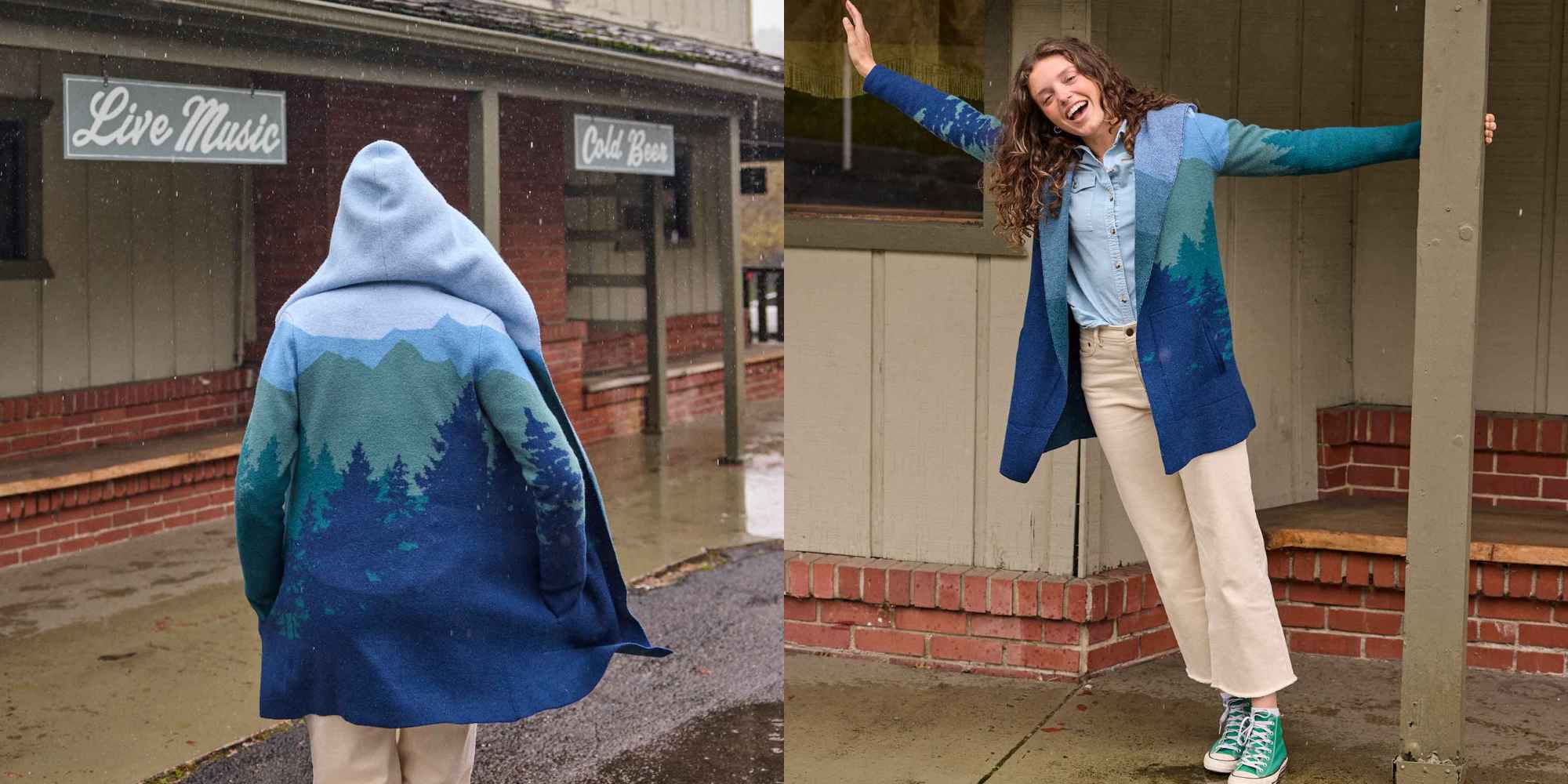
Woven with a beautiful alpine jacquard pattern, this hoodie is made from non-mulesed Merino wool and features pockets at the sides. It’s ideal as a mid-layer under a longer coat when you’re out exploring, or as a cosy item for grabbing a post-walk hot chocolate.
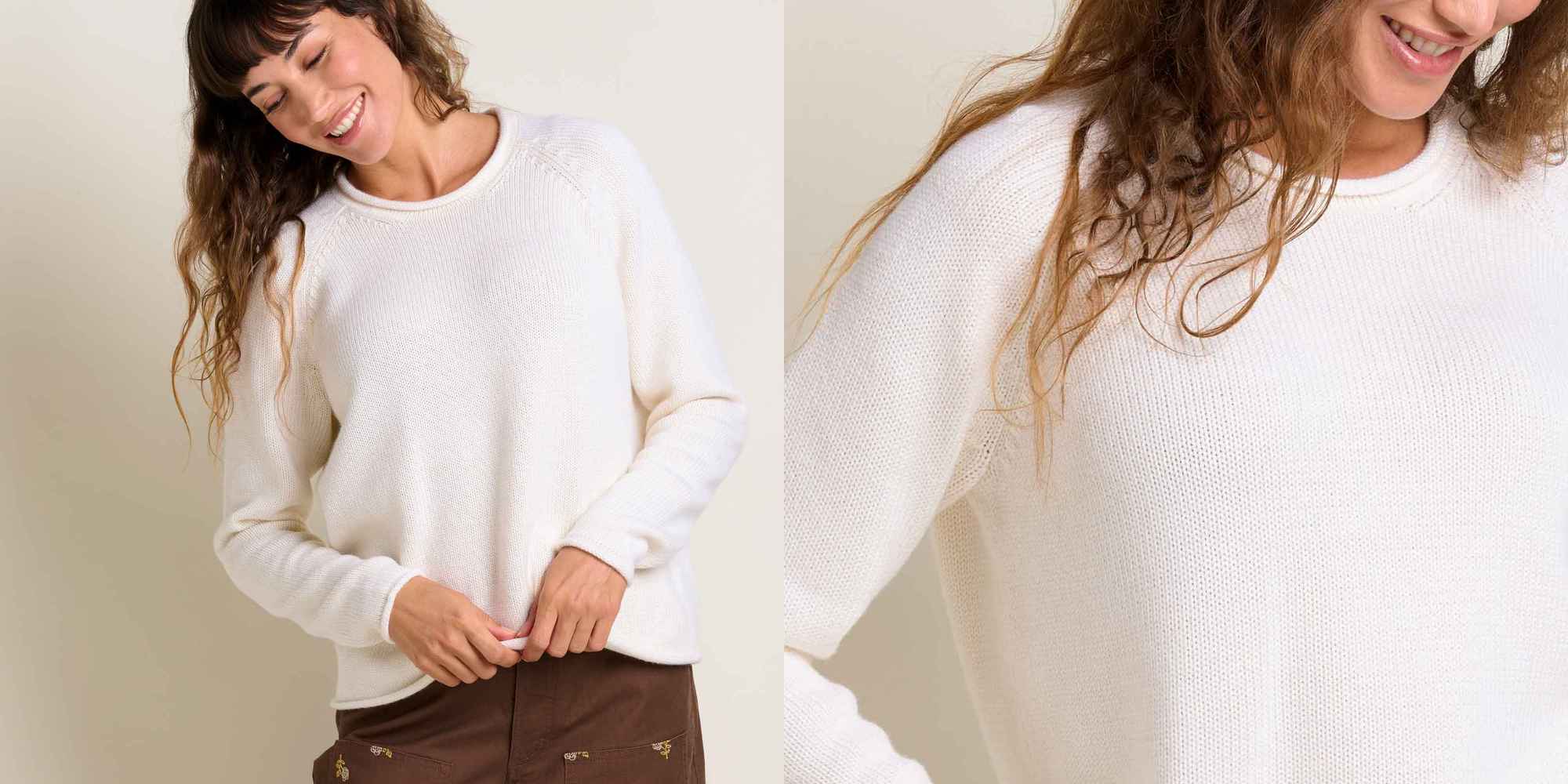
This Alpineglo sweater is a blend of 50% organic cotton and 50% non-mulesed Merino wool, so it’s going to help regulate your temperature in most climates. On top of that, the neutral tone and straight fit make it really versatile—you’ll be reaching for it on the regular.
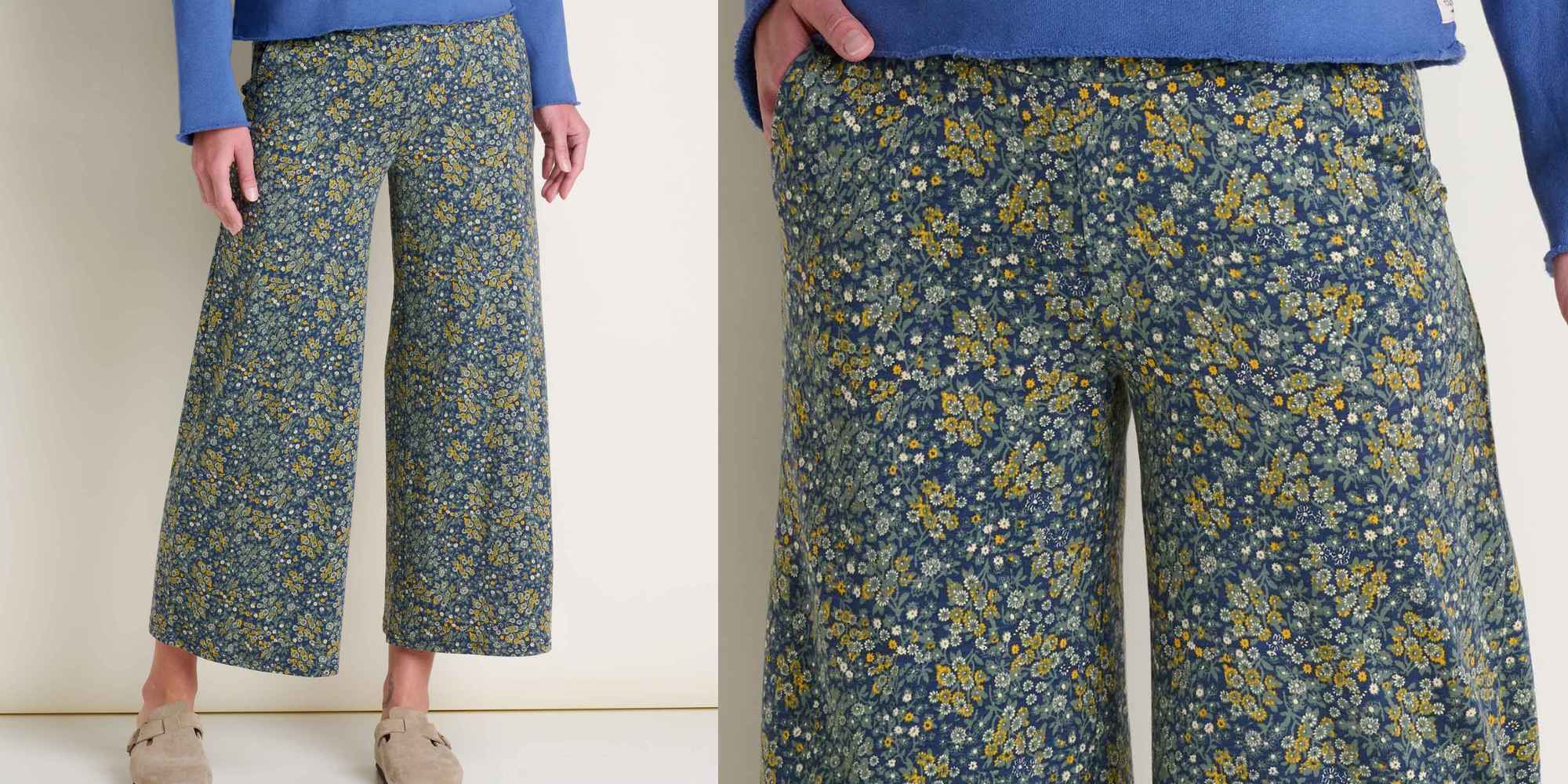
Toad&Co calls these cropped trousers “sweatpant comfortable, going-out presentable”, which makes sense, given they’re made with organic cotton and Tencel Lyocell for softness and have a comfortable wide waistband, not to mention a pretty floral pattern.
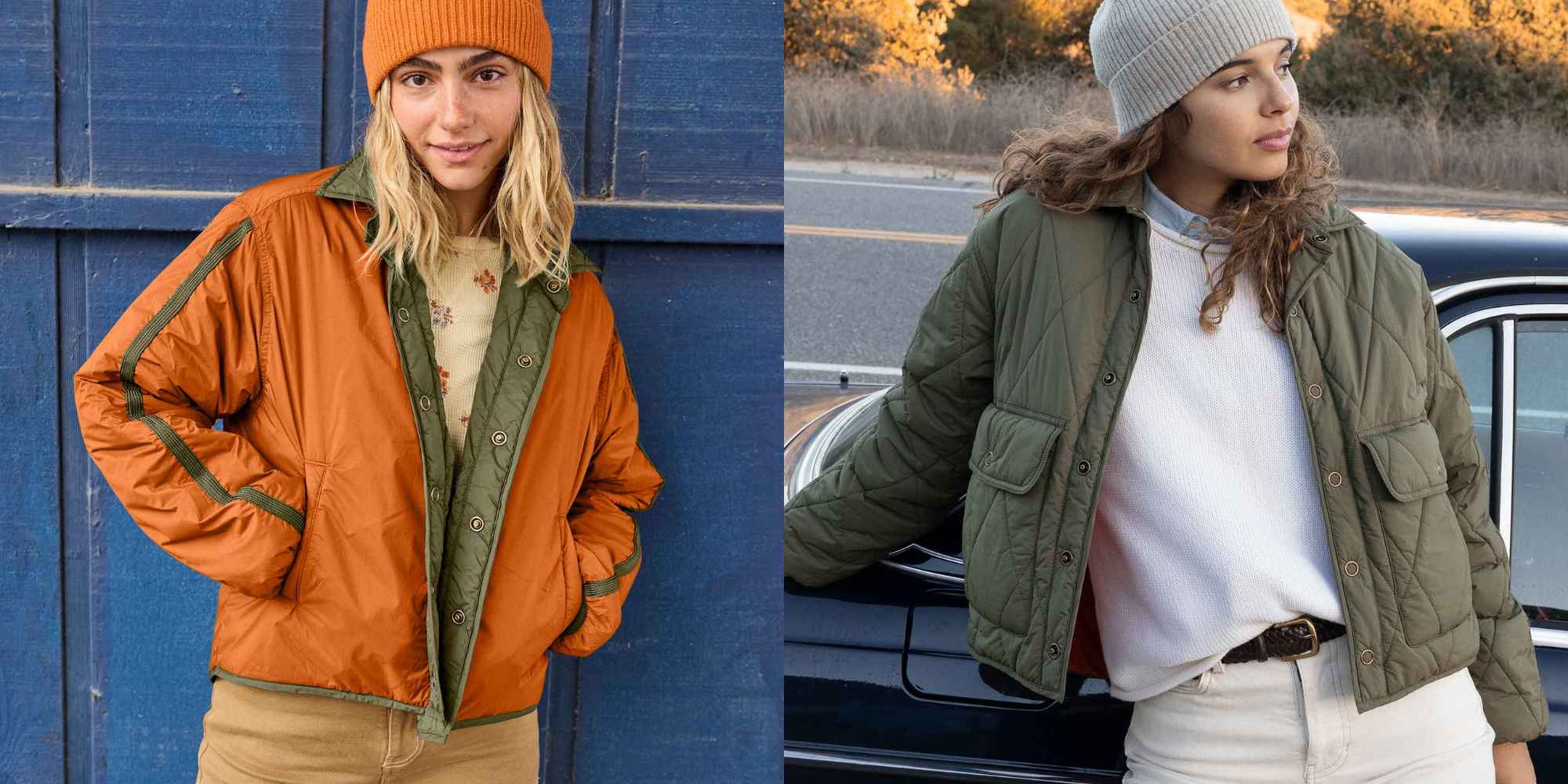
This Nomader jacket is reversible, packable, and water-resistant. In other words, it’s the ideal item to take with you for outdoor adventures. It’s made from recycled nylon and lightly quilted for warmth.

Toad&Co picked the crepe-like organic cotton for this jacket so that you could fold it away in a bag and have it still look presentable when you pull it out. It’s also packed with recycled polyester padding for extra warmth.
 Balsam Cutoff TrousersThese Balsam Trousers are made with a tiny bit of stretch and a special waistband for comfort, so they’ll flex with you and feel good all the time. The neutral brown colour also goes with so many options.
Balsam Cutoff TrousersThese Balsam Trousers are made with a tiny bit of stretch and a special waistband for comfort, so they’ll flex with you and feel good all the time. The neutral brown colour also goes with so many options.These Balsam Trousers are made with a tiny bit of stretch and a special waistband for comfort, so they’ll flex with you and feel good all the time. The neutral brown colour also goes with so many options.

Going from a walk to dinner? From the office to drinks? This Kennicott shirt jacket fits the bill for all of the above. The smart twill fabric incorporates recycled Italian wool.

This is Toad&Co’s Re-Form Herringbone: a blend of recycled cotton and polyester that offers a soft drape and an attractive herringbone weave that looks smarter than the average checked shirt.
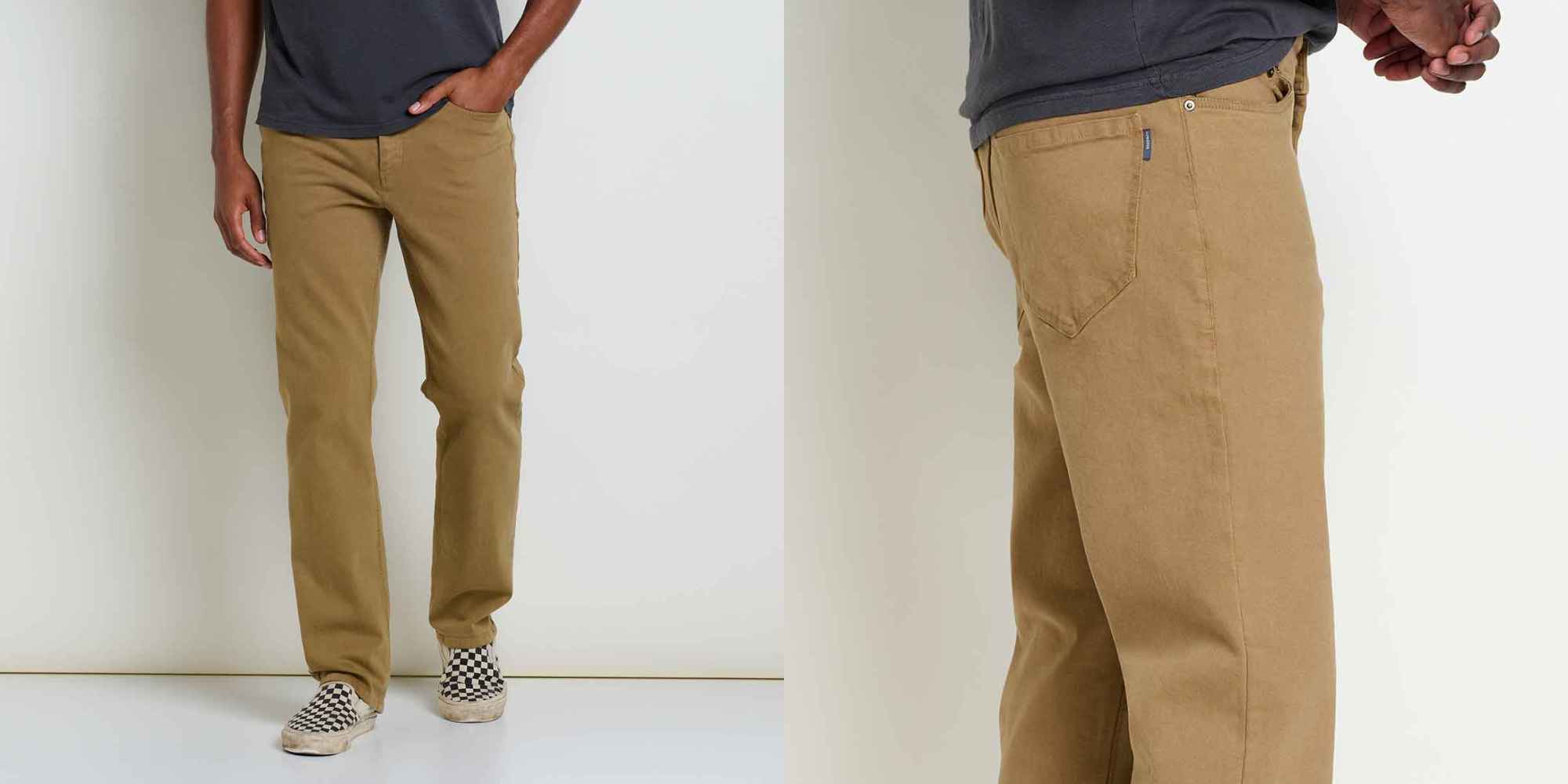
Like the women’s equivalent, these Balsam trousers have a touch of stretch and a comfortable ‘FlexForm’ waistband that mean they’re going to feel comfortable from the get-go—and you won’t need to worry about a belt, either.
Discover more of Toad&Co’s clothes.
The post How Toad&Co’s Clothes Help Everyone Enjoy the Outdoors appeared first on Good On You.
Green Living
50 DIY Christmas Presents Anyone Can Make
Last Updated on November 21, 2025
If you’re on the handmade Christmas kick this year, you’re not alone. So am I!
I’m choosing presence over presents this year and bringing back the 90s Christmas I loved as a kid – simple, crafty, low pressure, and full of small moments that feel meaningful.

If you want to gift thoughtfully, and without breaking the bank, these DIY Christmas presents are for you. There’s something for everyone on this list – whether you prefer easy or complex DIYs.
I’ve included all kinds of DIYs – beauty, cooking, fashion, and practical gifts alike. Best of all? Many of these tutorials are zero waste (or close to it).
what are good homemade Christmas gifts?
Good homemade Christmas gifts include consumable items, like homemade nut butters, vanilla extract, or jams. But not all homemade gifts are edible – you can also make items like bath bombs, candles, body scrubs, beeswax wraps, and so much more.
If you’re extra crafty, you could even make wooden gifts (like shelving or tablet holders), ceramic items (like mugs or jewelry), or knitted/crocheted pieces (like blankets, scarves or hats).
It all depends on your level of skill, time at your disposal, and ingredients/materials you have access to.

what are good inexpensive Christmas gifts?
Some good inexpensive Christmas gifts are DIY cornstarch ornaments, handmade body or lip scrub, seasoned salt blends, and homemade treats (like these chocolate chip cookies or vegan sugar cookies).
And never forget to hit up your local thrift store – you can find so many great items that would make affordable gift baskets!
Wrapping DIY Christmas gifts also doesn’t have to be expensive. Reusing gift bags and ribbons from last year, upcycling packaging paper, or even repurposing a scarf for furoshiki wrap are all low-waste and affordable!
RELATED: Gift Wrapping: How to Keep It Easy, Eco and Chic
how can I make a last minute gift?
You can make a last minute gift by getting crafty using the materials you have on hand!
For example, if you have a cardboard box, why not try making an upcycled cardboard dollhouse, vehicle, or pirate ship for a child? For adults, a DIY storage container or a shoe rack works.
One of my fav last minute gifts is scented bath salts in an upcycled glass jar – just a little Epsom salt and essential oil blends will do the trick!
Here’s my list of DIY Christmas gifts – something for everyone and every skill level.

- Bath salts
- DIY makeup like mascara/eyeliner, or lip to cheek
- Bath bombs
- Lip scrub
- Lip balm
- Face mask
- Body lotion
- Natural perfume
- Dry shampoo
- Shampoo bar
- Body soap
- Deodorant
- Rose water toner
- Hand-poured coconut/soy/beeswax candles
- Simmer pot in a jar
- Cookie, brownie, soup mix or hot cocoa mix in a jar
- Handmade seasoning blends
- Vanilla extract
- Vegan caramels or plant-based butter wrapped in compostable parchment paper
- Herb or citrus infused olive oil
- Peanut butter + jam
- Beeswax wraps
- Apple or pumpkin butter
- Sourdough or no-knead artisan bread
- Finished embroidery hoops
- Embroidered pillows, tote bags, clothes or cloth napkins
- Sewn cotton rounds
- Knitted scarf, hat, gloves, sweater, or blanket
- Hand warmers
- Quilt blanet, quilted coat or quilted wallet
- Tie dyed secondhand silk scarves, clothing or sheets
- Hand painted or drawn artwork
- Air dry clay paint palette
- DIY wooden frame for paintings or print photos
- Handmade ceramics (mugs, chawan, chasen holder, vase, spoon rest, etc.)
- Woodworked items (birdhouse, shelving, bookcase, wall guitar mount)
- Carving wooden bowls by hand
- Natural branch coasters
- Plant propagations in one of these DIY planters
- Seed balls using native seeds
- Handwoven baskets or bowls
- Macrame produce bag
- Macrame plant hanger
- Fabric paper mache bowls
- Upcycled paper earring jewelry
- Clay earrings
- Handmade plush toys
- Felt ‘food’ toys
- Wooden toys (like vehicles, blocks, or dollhouses)
- Knit or crocheted baby clothes
What do you think of these DIY Christmas presents? Let me know in the comments!
The post 50 DIY Christmas Presents Anyone Can Make appeared first on Going Zero Waste.
Green Living
8 Best Non Toxic Rugs For a Sustainable Home
Last Updated on November 6, 2025
Did you know most rugs are made from polyester, aka plastic? Arguably, a good chunk of our furniture and home decor is nowadays.
And lets not forget – rugs can get a lot of foot traffic. If it’s made from polyester, chances are those plastic fibers are going to shed and get onto us. Or worse, in us.

Some of the links in this post are affiliate links; for more information please see my disclosure policy.
Microplastics have been found in human feces, blood, and even placentas. And according to a study from Stanford University, those who had microplastics in their plaque had a higher risk of heart attack, stroke and death than those who didn’t.
On top of this, 5 billion pounds of rugs go to waste each year – that’s 2% of total US landfill. And if they’re made from plastic? They won’t biodegrade.
It’s more important than ever to reduce our exposure to microfibers where we can. Which is why I’ve rounded up the best non toxic rugs on the market.
what is the least toxic rug?
The least toxic rug will have sustainable materials and use no harsh chemicals (like PFAs) in their production.
Here’s what to look for when purchasing a non-toxic rug:
- Sustainable materials, such as organic cotton, jute, sisal or wool
- Low-waste packaging + delivery
- Natural, non-synthetic dyes
- Third-party certifications like OEKO-TEK, Fair Trade, GOTs
- Easy to spot-clean or machine wash
- Available in various styles, patterns + colors to suit your needs
do all rugs have PFAS?
According to Department of Toxic Substances Control (DTSC), only four samples of 201 carpets and rugs were found to contain more than 100 parts per million in their fibers, indicating PFAS were intentionally added to the products.
However, while PFAs may not be a huge concern for rugs, microplastic pollution is, specifically if your carpet is synthetic. Your best bet is to check the material your rug is made from and choose natural fibers whenever possible.
what is the best non-toxic rug for nursery?
The best non-toxic rug for a nursery would be made from natural materials like wool and organic cotton (which are soft on baby’s skin).
I recommend also checking for natural latex for the rug backing and underlay pads. Brands on this list that offer kid-friendly sizes and patterns include Lorena Canals, Nestig, Quince, and Loomy (more on each below).
what brand of rugs are non-toxic?
The brands of rugs that are non-toxic are listed below. I’ve gone ahead and highlighted some of my favorite features of each brand, but it isn’t an exhaustive list. Be sure to check out their websites for more information.

1. hook and loom
- Various rug sizes, shapes + patterns
- Made from GOTs certified organic cotton, recycled cotton + wool
- No dyes or harmful chemicals
- No latex
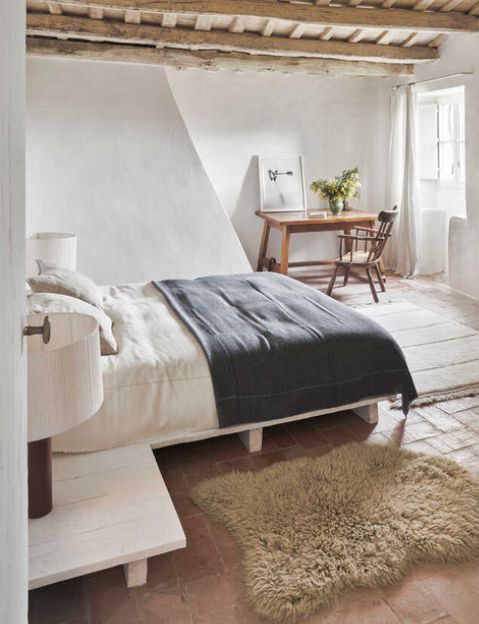
2. lorena canals
- Various rug sizes, shapes + patterns
- Handmade by artisans using recycled materials like organic cotton + wool
- Nontoxic dyes
- Make your own option
- Machine washable
- Rugcycled line made from recycled materials in their own factory

3. sabai
- Field rug
- Woven using wool + jute
- Available in 3 varying sizes
- Rug pad add-on available for reduced movement
- Certified B Corporation

4. quince
- Various sizes + patterns, best known for vintage-inspired looks
- Made from natural materials like wool, jute, + cotton
- Handcrafted by artisans in India
- Transparent pricing practices
- Compostable poly bags + recycled plastic mailers
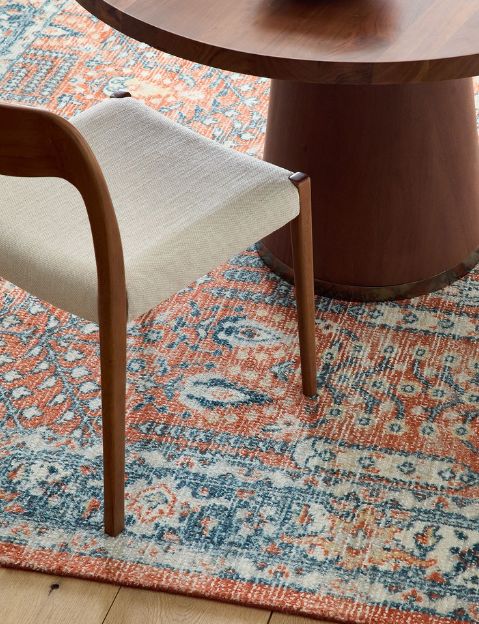
5. west elm
- Rugs for every area of the home, in varying sizes
- Made from wool, jute, hemp, cotton, TENCEL + recycled materials
- Handspun by skilled artisans in India
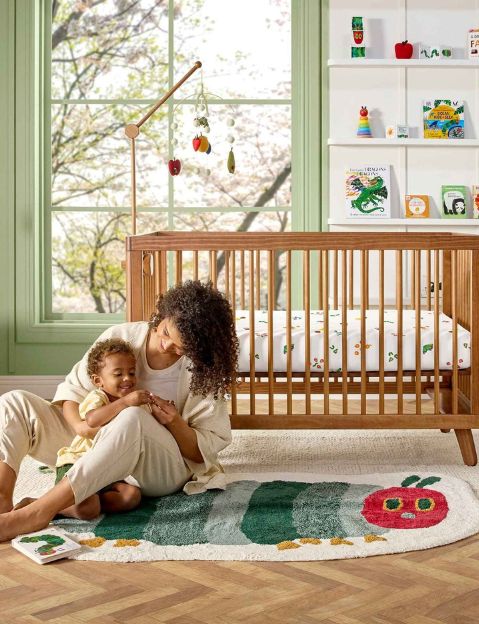
6. nestig
- Area + washable rugs made with fun shapes/designs for babies + kids
- Washable rugs made with organic cotton + nontoxic dyes
- Area rugs made with cotton + each colored element crafted from recycled cotton
- Handmade in Brazil

7. cold picnic
- Various rug shapes + sizes, abstract patterns + bold colors
- Made with wool, bamboo silk, cotton, hemp, + deadstock materials
- Designed in a Brooklyn studio, handmade by artisans in India
- Committed to reducing packaging waste where possible

8. loomy
- Various rug sizes, shapes + patterns
- Made from banana silk, hemp, jute, recycled fiber, viscose, or wool
- Any colored yarn dyed using low-impact techniques
- Handcrafted by indigenous artisans
So what do you think of these non toxic, sustainable rugs? Let me know in the comments!
The post 8 Best Non Toxic Rugs For a Sustainable Home appeared first on Going Zero Waste.
-
Climate Change4 months ago
Guest post: Why China is still building new coal – and when it might stop
-
Greenhouse Gases4 months ago
Guest post: Why China is still building new coal – and when it might stop
-
Climate Change2 years ago
Spanish-language misinformation on renewable energy spreads online, report shows
-

 Greenhouse Gases2 years ago
Greenhouse Gases2 years ago嘉宾来稿:满足中国增长的用电需求 光伏加储能“比新建煤电更实惠”
-
Climate Change Videos2 years ago
The toxic gas flares fuelling Nigeria’s climate change – BBC News
-

 Climate Change2 years ago
Climate Change2 years ago嘉宾来稿:满足中国增长的用电需求 光伏加储能“比新建煤电更实惠”
-

 Carbon Footprint2 years ago
Carbon Footprint2 years agoUS SEC’s Climate Disclosure Rules Spur Renewed Interest in Carbon Credits
-
Climate Change2 years ago
Why airlines are perfect targets for anti-greenwashing legal action



